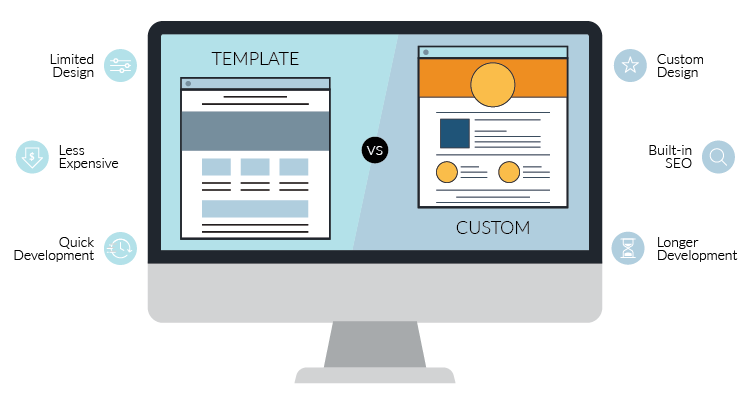Using website templates and custom design both have their own pros and cons. Let’s explore them in more detail:
Website Templates:
Pros:
 Cost-effective: Website templates are often more affordable compared to custom design since they are pre-designed and readily available.
Cost-effective: Website templates are often more affordable compared to custom design since they are pre-designed and readily available. Time-saving: Templates offer a quick solution for creating a website as you don’t have to start from scratch. You can simply customize the template according to your needs.
Time-saving: Templates offer a quick solution for creating a website as you don’t have to start from scratch. You can simply customize the template according to your needs. Design inspiration: Templates provide a starting point and can give you design ideas and inspiration, especially if you’re not sure about the visual direction of your website.
Design inspiration: Templates provide a starting point and can give you design ideas and inspiration, especially if you’re not sure about the visual direction of your website. Tested and optimized: Many templates are well-tested and optimized for responsiveness, mobile-friendliness, and usability, ensuring a good user experience.
Tested and optimized: Many templates are well-tested and optimized for responsiveness, mobile-friendliness, and usability, ensuring a good user experience. Ease of use: Templates often come with user-friendly interfaces and drag-and-drop functionality, making them accessible to individuals with limited technical skills.
Ease of use: Templates often come with user-friendly interfaces and drag-and-drop functionality, making them accessible to individuals with limited technical skills.
Cons:
 Lack of uniqueness: Since templates are pre-designed and available to others, there is a risk of your website looking similar to other sites using the same template. It may not effectively convey your brand’s individuality.
Lack of uniqueness: Since templates are pre-designed and available to others, there is a risk of your website looking similar to other sites using the same template. It may not effectively convey your brand’s individuality. Limited customization: While templates can be customized to some extent, you may face limitations in terms of layout, functionality, and overall design. It can be challenging to achieve a truly unique and tailored look.
Limited customization: While templates can be customized to some extent, you may face limitations in terms of layout, functionality, and overall design. It can be challenging to achieve a truly unique and tailored look. Code quality: Some templates may have poorly written or bloated code, affecting website performance and loading speed. It’s crucial to choose templates from reputable sources.
Code quality: Some templates may have poorly written or bloated code, affecting website performance and loading speed. It’s crucial to choose templates from reputable sources. Learning curve: While templates offer ease of use, there can still be a learning curve, especially if you’re new to website building and customization. Familiarizing yourself with the template’s specific features and customization options may take time.
Learning curve: While templates offer ease of use, there can still be a learning curve, especially if you’re new to website building and customization. Familiarizing yourself with the template’s specific features and customization options may take time.
Custom Design:
Pros:
 Unique and tailored design: With custom design, you have complete control over the appearance and functionality of your website. It can be designed to perfectly match your brand identity and goals.
Unique and tailored design: With custom design, you have complete control over the appearance and functionality of your website. It can be designed to perfectly match your brand identity and goals. Scalability and flexibility: Custom designs are more adaptable and scalable as your business grows and evolves. You can easily incorporate new features and functionalities without being limited by template constraints.
Scalability and flexibility: Custom designs are more adaptable and scalable as your business grows and evolves. You can easily incorporate new features and functionalities without being limited by template constraints. Enhanced performance: Custom-built websites allow developers to optimize code, resulting in faster loading times and better overall performance.
Enhanced performance: Custom-built websites allow developers to optimize code, resulting in faster loading times and better overall performance. SEO optimization: Custom design allows for better search engine optimization (SEO) implementation, improving your website’s visibility and rankings in search results.
SEO optimization: Custom design allows for better search engine optimization (SEO) implementation, improving your website’s visibility and rankings in search results.
Cons:
 Higher cost: Custom design requires more time, effort, and expertise, so it tends to be more expensive compared to using templates.
Higher cost: Custom design requires more time, effort, and expertise, so it tends to be more expensive compared to using templates. Longer development time: Building a custom website from scratch takes time, as it involves various stages of planning, designing, and development. The timeframe for completion may be longer compared to using a template.
Longer development time: Building a custom website from scratch takes time, as it involves various stages of planning, designing, and development. The timeframe for completion may be longer compared to using a template. Technical expertise required: Custom design often necessitates the involvement of professional web designers and developers who possess the necessary skills and knowledge. This can be a limitation if you lack technical expertise or have a limited budget for hiring professionals.
Technical expertise required: Custom design often necessitates the involvement of professional web designers and developers who possess the necessary skills and knowledge. This can be a limitation if you lack technical expertise or have a limited budget for hiring professionals. Maintenance and updates: Custom-built websites may require ongoing maintenance and updates to ensure compatibility with evolving web standards, browser updates, and security patches. This may involve additional costs and efforts.
Maintenance and updates: Custom-built websites may require ongoing maintenance and updates to ensure compatibility with evolving web standards, browser updates, and security patches. This may involve additional costs and efforts.
Ultimately, the decision between using website templates or opting for custom design depends on factors such as budget, timeline, level of uniqueness desired, and specific needs and goals of your website.


